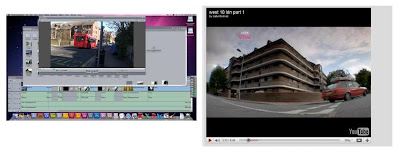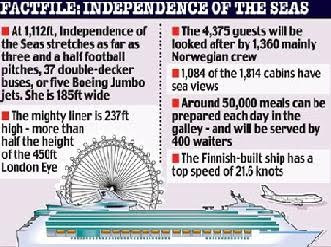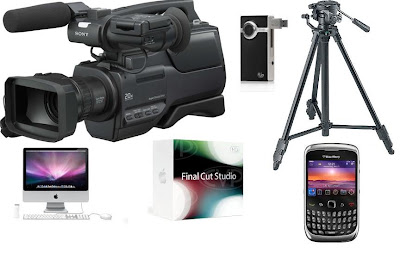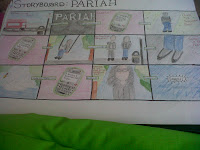In summary, my media product used many conventions from real products to aid in me creating a fluid plot with good camera shots and angles.
Q2:How Effective is the Combination of Your Main Product and Ancillary Texts
From audience feedback I was told that the combination of my main product and ancillary texts worked quite well together. The most common thing I was told was that 'The use of the same music in the film and in the trailer is very effective as it makes it memorable.'
This is key as the repetition of the song creates familiarisation with the audience and will entice them to want to watch my product. This was also the case with the font in the title sequence in the film and the font in the magazine article. The use of this repetition can create a brand for my film and this will further its popularity. With the theme of 'The struggle for Identity' as my basis, I feel that the picture in my article was quite effective. This is because only showing half of the face connotes that she doesn't have an identity and also implies some sort of struggle.
Overall, I feel that all three products complimented each other and linked quite well into my research and planning.
Question 3: What have you learned from your audience feedback?
Through this audience feedback I learnt ways in which I could improve the production. After interviewing a sample from my target audience, I learnt that many found the plot confusing, some even said that a better actress was needed.
This has lead me to think of ways that I would change my production if I were to do it again, and I thought that I would be better if:
-I had a range of actors/actresses
-Had a more vibrant location
- Thought more about props
I also thought of some additional ideas, such as:
-A variety of ethnicities to be displayed in my production to really show the theme of identity
-I would also add a voice over and sound bridges into the film as it is a way of showing the plot in a different light
I believe that the audience feedback has been very useful for me as it allowed me to see what I could have done differently and showed me what was effective in my product.
Question 4: How did you use media technologies in the construction, research, planning and evaluation stages? on Prezi
I also used my blackberry smartphone to get audience feedback and I obtained this through videos and voice notes. Using varied technologies helped a great deal as it showed my awareness of technology as well ask showing my ability to use social media to improve my outcome.

 Time management was an issue that my partner and I could definitely work on. We strayed from the SMART targets that we made previously and this was quite bad as it interfered with editing time. In hindsight I would have had a time management meeting where my partner and I discussed how much time we would spend on each aspect of the production pieces. Our time management was also affected by the delay of the equipment being delivered to our college and other technological problems such as the apple mac computer network being down. In future, I will leave time for problems like this to prevent them affecting my work.
Time management was an issue that my partner and I could definitely work on. We strayed from the SMART targets that we made previously and this was quite bad as it interfered with editing time. In hindsight I would have had a time management meeting where my partner and I discussed how much time we would spend on each aspect of the production pieces. Our time management was also affected by the delay of the equipment being delivered to our college and other technological problems such as the apple mac computer network being down. In future, I will leave time for problems like this to prevent them affecting my work.
Here is the radio trailer we produced using Final Cut Pro Ignore the images, they aren't supposed to be there!!!
Pariah (ORIGINAL)
(Starts with music from the film)
Voice: Sometimes saying nothing is the best thing to do.
Starring Best Newcomer: Debbie Adedeji
From the makers of ‘The Highlife’ comes ‘Pariah’
Reviewer 1: It was a very moving film.
Fade into music and fade out
Reviewer 2: The twist at the end was really unexpected and made the film a must see.
Fade into music and fade out
Reviewer 3: The characters were so realistic and really showed the issue well.
(With music in the background)
-‘Groundbreaking short film of the year’ says The Sun
-‘Manages to portray serious issues in a way that entices the viewer’ says The Independent
-‘A fascinating and captivating tale that compliments the British Film Industry’ says Time Out

As we didn't use an original track, I sent a message to the creator of the music to ask if i had permission to include it in my film. They agreed and said that they would love to see the finished product.
We chose this as we felt that it fitted in very well with the themes of our film and worked very well with the plot and location.
As the genre of our film is drama, we thought that it would be best that we keep within the genre and find some music to suit this.
When beginning this process, I thought of drama films that I had already seen and the type of music that was used in them. For example, 'Adulthood' had quite dramatic harsh music to portray how the character felt and to show the themes (see below).
The genre of grime music was used in the 'Adulthood' film and it acted as a link to the themes of youth in the film and it linked with the characters and storyline very well. This is what I aim to do with my music choice.
The other genre that I looked at was R&B. This is quite effective as well as the lyrics are meaningful compared to genres such as rap, and the beat can also make a difference and add character to the film. However, as we wanted to use the track in the background of our film, we felt that it would be best if we chose a song without lyrics.
Here is another example of music from a drama film:

Above are some shots from our editing session where we discussed the organisation of clips and the way our montage will look at the end of production. We realised that the current order that it was in didn’t shape the plot properly. We also found that some parts of the film were long and drawn out and that we could cut it to prevent our audience from losing interest. We also found some shots that we could use to create suspense and drama and they were quite shadowy, this would link in with the Neo-Noir movement.
 We wanted our whole production to have good continuity so we thought that it would be good to have one strong font in the title sequence of the film and in the magazine article.
We wanted our whole production to have good continuity so we thought that it would be good to have one strong font in the title sequence of the film and in the magazine article.
At our second meeting we planned dates for filming, as we couldn’t upload our current footage onto the Apple Macs because our college was having some technical difficulties with the computer network.
We also looked at the storyboard and separated it over a course over 3 weeks so we had sufficient time to film each scene.


‘Storyboards are graphic organisers such as a series of illustrations or images displayed in a sequence for the purpose of pre-visualising a motion picture, animation, motion graphic or interactive media sequence including website interactivity.' - Wikipedia
The common storyboarding used today was pioneered at the Walt Disney Studio in the 1930s. Gone with the Wind was one of the first live action films to be completely storyboarded.

I have used Final Cut Pro before but I need to improve my skills to ensure that the finished product is successful. The first thing I did was refresh my mind with some basic skills:










